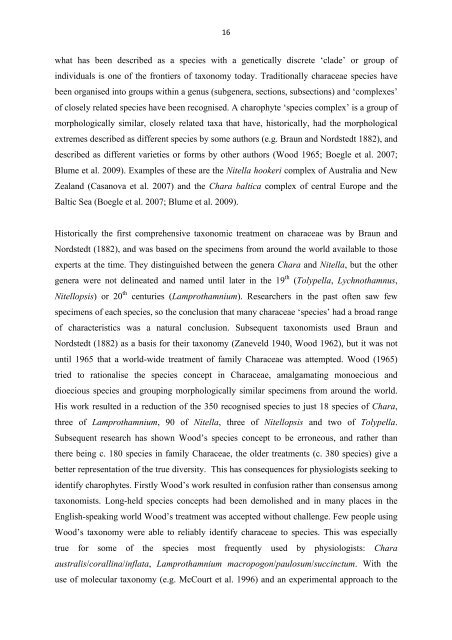Chapter 1: The Characeae Plant
Chapter 1: The Characeae Plant
Chapter 1: The Characeae Plant
Create successful ePaper yourself
Turn your PDF publications into a flip-book with our unique Google optimized e-Paper software.
16 <br />
what has been described as a species with a genetically discrete ‘clade’ or group of<br />
individuals is one of the frontiers of taxonomy today. Traditionally characeae species have<br />
been organised into groups within a genus (subgenera, sections, subsections) and ‘complexes’<br />
of closely related species have been recognised. A charophyte ‘species complex’ is a group of<br />
morphologically similar, closely related taxa that have, historically, had the morphological<br />
extremes described as different species by some authors (e.g. Braun and Nordstedt 1882), and<br />
described as different varieties or forms by other authors (Wood 1965; Boegle et al. 2007;<br />
Blume et al. 2009). Examples of these are the Nitella hookeri complex of Australia and New<br />
Zealand (Casanova et al. 2007) and the Chara baltica complex of central Europe and the<br />
Baltic Sea (Boegle et al. 2007; Blume et al. 2009).<br />
Historically the first comprehensive taxonomic treatment on characeae was by Braun and<br />
Nordstedt (1882), and was based on the specimens from around the world available to those<br />
experts at the time. <strong>The</strong>y distinguished between the genera Chara and Nitella, but the other<br />
genera were not delineated and named until later in the 19 th (Tolypella, Lychnothamnus,<br />
Nitellopsis) or 20 th centuries (Lamprothamnium). Researchers in the past often saw few<br />
specimens of each species, so the conclusion that many characeae ‘species’ had a broad range<br />
of characteristics was a natural conclusion. Subsequent taxonomists used Braun and<br />
Nordstedt (1882) as a basis for their taxonomy (Zaneveld 1940, Wood 1962), but it was not<br />
until 1965 that a world-wide treatment of family <strong>Characeae</strong> was attempted. Wood (1965)<br />
tried to rationalise the species concept in <strong>Characeae</strong>, amalgamating monoecious and<br />
dioecious species and grouping morphologically similar specimens from around the world.<br />
His work resulted in a reduction of the 350 recognised species to just 18 species of Chara,<br />
three of Lamprothamnium, 90 of Nitella, three of Nitellopsis and two of Tolypella.<br />
Subsequent research has shown Wood’s species concept to be erroneous, and rather than<br />
there being c. 180 species in family <strong>Characeae</strong>, the older treatments (c. 380 species) give a<br />
better representation of the true diversity. This has consequences for physiologists seeking to<br />
identify charophytes. Firstly Wood’s work resulted in confusion rather than consensus among<br />
taxonomists. Long-held species concepts had been demolished and in many places in the<br />
English-speaking world Wood’s treatment was accepted without challenge. Few people using<br />
Wood’s taxonomy were able to reliably identify characeae to species. This was especially<br />
true for some of the species most frequently used by physiologists: Chara<br />
australis/corallina/inflata, Lamprothamnium macropogon/paulosum/succinctum. With the<br />
use of molecular taxonomy (e.g. McCourt et al. 1996) and an experimental approach to the
















